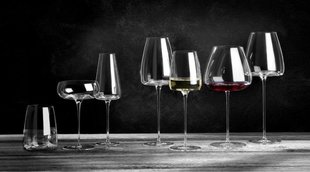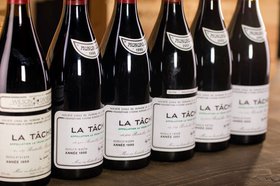Wine Glass (Styles, Best Wine Glasses for Each Wine Type)
What wine glasses should you use for different types of wine? How important is the role of the right wine glass to your experience of enjoying wine?
The right glass is said to bring out the best of your wine’s character and nuances.
All the different glasses - big and small ones, the flutes, goblets, and coupes may confuse you. But, don’t worry. You don’t have to be a sommelier to figure this out.
In this article, we’ll take you through the anatomy of a wine glass, why you use different glasses for different wines, and tips to choose them - so you’ll know exactly Which Wine Glass To Pair with the Red Wine or Dom Perignon in Your Wine Cellar!
You’ll also discover the best way to buy the finest wines to put your prized stemware to good use throughout the year!
Further reading
On the topic of wines, want to know more about French wines and some of the best wine brands you could buy? Check out these informative articles:
Why Should You Use a Proper Wine Glass for Serving Wine?
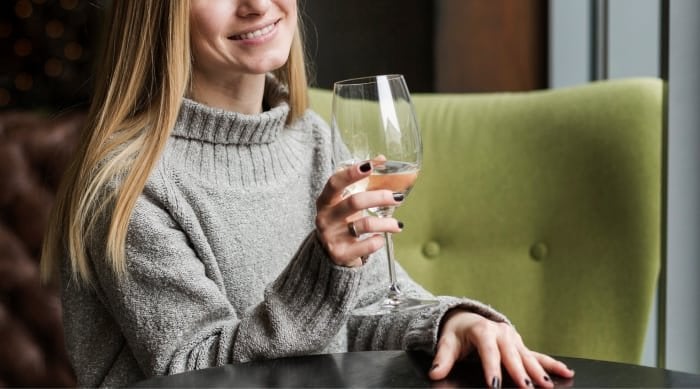
A large part of enjoying wine lies in savoring its aroma. The wine glass has to gather the wine’s aroma so you can savor it when you drink.
If you use a regular mug and fill it to the brim, all the characteristic vapors of the wine will be gone by the time you start to sip.
But, there’s more to it than just enjoying the wine’s aroma.
First, let’s step back to see how the modern wine glass came to be.
A Brief History of the Wine Glass
The earliest form of wine glasses are believed to be the silver and pottery goblets used by the Romans in the third century.
The wine glass that you know today, with the base, stem, and bowl, originated in the 1400s in Venice, Italy, where some of the best glass makers were centered.
But it was Claus Riedel in the 20th century, who was the first to acknowledge the correlation between the wine’s taste and the wine glass shape. He launched the first series of glasses designed to suit a wine’s character.
Since then, the wine glass has evolved to suit the different shapes and styles to suit the character of different types of wine, and Riedel continues to be a leading glassware brand.
Wine Glasses: Anatomy and Materials Used
How does a wine glass shape influence the drinking experience?
The wine glass shape is not only meant to collect the wine’s aroma but also influences how much wine flows into your mouth. It determines whether the wine moves across the tongue or spreads to the side.
This can actually make the same wine taste quite different indeed!
Parts of a wine glass

The wine glass can be a machine-blown or handmade glass and has these four parts, from bottom to top:
1. Foot
This is the flat base section of the glass that will hold the glass upright on your dining table. A small foot can make the glass imbalanced, and the glass will easily topple on your dining tables. Too large a foot might get stuck under your platters and flatware or tableware.
2. Stem
The stem is the thin, neck section where you usually hold the wine glass or stemware. Holding it there prevents you from heating the wine with your fingers. It also keeps you from smudging the bowl with your fingerprints.
3. Bowl
The bowl is where you’ll see the most variation in wine glasses. The opening will usually be smaller than the shoulder (widest part of the bowl). This shape captures the aroma of the wine.
The bowl’s width determines the surface area of the wine. Some wines should be allowed to “breathe” more than others — this is typical of aged reds with intense, complex aromas.
4. Rim
The thinness of the rim can affect how you perceive the wine’s taste. A glass with a thin rim is much better than a thick rim glass, as it’ll let the wine flow smoothly into your mouth.
Wine glass materials
Wine glasses can be made of many different materials. While glass and crystal are the most common, alternate materials like acrylic and silicone are also used.
1. Soda-lime glass
Most glasses are of the soda-lime variety. It’s the same type of glass you’ll find on your window panes or food jars.
When used for wine glasses, it has the advantage of being more affordable than crystal. It’s inert and nonporous, meaning it won’t absorb chemical aromas, so it’s always dishwasher safe. That said, soda-lime wine glasses will tend to be thicker than crystal stemware and are more durable.
2. Crystal
Crystal wine glasses contain 2-30% of added minerals, which is its primary difference from regular glasses. Those minerals could be lead, magnesium, or zinc, allowing the crystal to be spun much thinner than glass but still retain structural strength.
Crystal glassware also refracts light better, making your wine look sparkly in the glass.
However, the addition of minerals to the crystal makes it porous and not always dishwasher safe.
You also have the option of leaded vs. lead-free crystal stemware:
A. Leaded crystal
Historically, all crystal glasses had lead added, and many still do. Leaded crystal wine glasses are safe, as your wine won’t stay long enough in the glass for the lead to leach into it.
But some glass manufacturers have moved to lead-free crystal because of the potential health concerns (like storing liquor in a leaded decanter for a longer period).
B. Lead-free crystal
Lead-free crystal glasses typically have magnesium or zinc additions and are usually dishwasher safe.
Manufacturers like Schott Zwiesel have gone a step further, patenting a crystal called Tritan®, which has infused titanium and zirconium. This makes a highly break-resistant lead-free glass.
Note:Tritan® shouldn’t be confused with Eastman’s TritanTM. TritanTM is a type of plastic also used to manufacture wine glasses.
3. Alternative materials
Other materials commonly used for lower-end wine drinking glasses would be acrylics, metals like stainless steel and silicone.
Wine glass decoration

Most high-end wine glasses won’t have designs on the bowl, as you don’t want to distract the view of the wine. You may come across a few exceptions like the Mikasa Cheer White Wine Glasses that have designs on the bowl.
However, you’ll often find finely decorated stems on some of the wine glasses.
In the 18th century, glassmakers would draw spiral patterns on the stem. You’ll find these even now on antique and vintage glassware.
What is a “Standard Pour” of Wine?
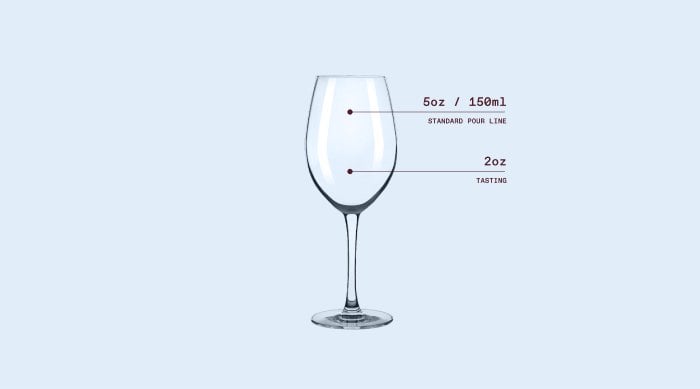
Usually, in restaurants, a glass would be around 5oz (~150ml). This portions a 750ml bottle of wine into five servings.
For wine tastings, the standard is around 2oz, which is enough to experience the wine’s aroma and flavor without being affected by the alcohol too fast.
Dessert wine servings are around 2oz, too, as these wines are much sweeter and have more alcohol than other wines.
Next, let's look at some of the best styles of modern wine glasses that you should try.
Wine Glasses to Buy in 2020 (By Wine Type)
In general, red wine glasses have rounder bowls, and white wine glasses have more U-shaped and upright bowls. Sparkling wine (Asti Spumante, for example) is usually had in tall flutes, and dessert wines in smaller glasses.
1. Red Wine Glass

Zalto Denk'Art Bordeaux Glass
Red wine glass has a round, wide bowl, like balloon glasses. The shape increases the exposed surface area of the wine, allowing more oxygen to interact with the liquid. Brief exposure to oxygen helps smoothen the complex flavors and tannins in red wine.
There are three types of red wine glasses:
A. Bordeaux glass
This tall glass is meant for bold, full bodied red wines like Cabernet Sauvignon, Cabernet Franc, Merlot, or Bordeaux Blends.
The glass is tall, but the bowl isn’t quite as large. The bowl’s height creates more space between the wine and nose, allowing room for ethanol vapors to escape, letting you get more of the wine’s aroma and less alcohol vapors.
Some Bordeaux wine glasses to consider:
- Zalto Denk'Art Bordeaux Glass
- Schott Zwiesel Tritan Pure Bordeaux Glass
B. Standard (Medium-bodied) wine glass
This is an excellent choice for medium- to full-bodied red wine, like Syrah or Malbec. The smaller opening will soften the spicy expression of some of these wines as it hits your tongue, but it keeps the aroma in the glass.
Add these standard red wine glasses to your barware:
- Riedel Vinum Syrah / Shiraz Glass
- Schott Zwiesel Tritan Crystal Pure Cabernet Glass
C. Burgundy (Bourgogne) glass
The Burgundy glass is designed for light, delicate red wine like Montrachet. The broad bowl creates space for aromas to collect, and a shorter lip directs the wine to the tip of the tongue so that you can taste more of its subtle flavors. The Pinot Noir glass is an example of the Burgundy glass.
Sip your Beaujolais Nouveau, Montepulciano d'Abruzzo, Pinot Noir or Nebbiolo in red wine glasses like these:
- Schott Zwiesel Pure 23.4 Ounce Burgundy Glass
Spiegelau Crystal
Wine Glass
What is the Difference Between Red Wine and White Wine Glasses?
A quick way for a wine lover to tell the difference is this: red wine glasses (like a Pinot Noir wine glass) have a larger bowl and wider rims than white wine glasses.
This is because red wine like Pinot Noir has a bolder, stronger flavor than white wine, so it needs more space to “breathe.”
And why is it recommended that wine be swirled before drinking?
This increases the exposed surface area even more and releases the aromatic compounds of the wine.
2. White Wine Glass and Rose Wine Glass
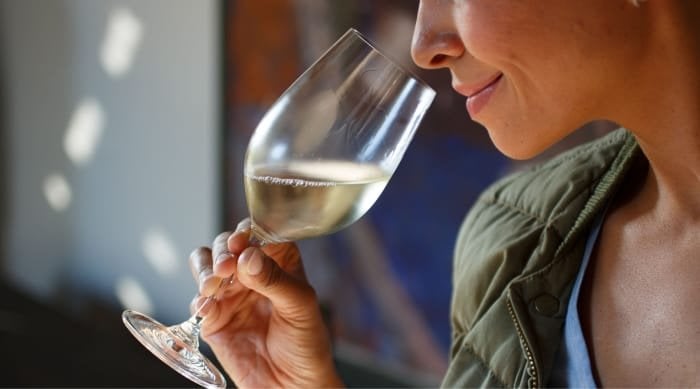
White and rose wines can use the same glass style. The white wine or rose wine glass is more U-shaped (tulip shaped) than round and is smaller than the red wine glass. This helps maintain the wine’s cooler temperature and concentrate the subtle floral aromas.
There are two types of white wine or rose wine glasses:
A. Glasses for high acid wines
This glass has a smaller bowl of the two. The design lets the wine move the middle of the palate and express more of its acidity. Try this glass with Sauvignon Blanc, dry Rieslings, or rosé wines.
Experience the subtle aromas of whites with these wine glasses:
- Spiegelau Willsberger White Wine Glass
- Riedel Vinum Riesling Grand Cru/Zinfandel glass
B. Glasses for full-bodied wines
Full-bodied white wines have richer aromas and flavors that benefit from the rounder shape and wider opening of these glasses. This is the glass for Chardonnays.
Drink your full-bodied white with these:
- Waterford Elegance wine glass
- Riedel Vinum Viognier/Chardonnay glass
3. Sparkling Wine Glass

Marquis by Waterford Champagne Flute
Bubblies have specific glass styles too, and the two types of sparkling wine glass you’ll find are quite different from each other.
A. Champagne flutes
Flutes usually have a long stem with a tall, narrow bowl. The narrow shape of this sparkling wine glass lets the bubbles last longer before sparkling wine turns flat. There’s also some roughness at the bowl’s base to help the bubbles form and travel upwards attractively!
Keep your sparkling wine glass clean, or the bubbles may also form wherever there’s roughness from dirt!
Some elegant Champagne flutes to consider:
- Riedel Ouverture Champagne Glass
- Marquis by Waterford Champagne Flute
B. Coupe
The coupe glass, also known as Champagne saucers, were trendy in the early 20th century. It’s not as popular these days for sparkling wine, as it’s wide, shallow bowl naturally lets the bubbly beverage get flat fast.
However, it does make a great cocktail glass. Drink quickly if you use this glass for sparkling wine.
Champagne coupes for your glassware collection:
- Schott Zwiesel Glass Saucer
- LSA International Wine Champagne Saucer
4. Dessert (Fortified) Wine Glass
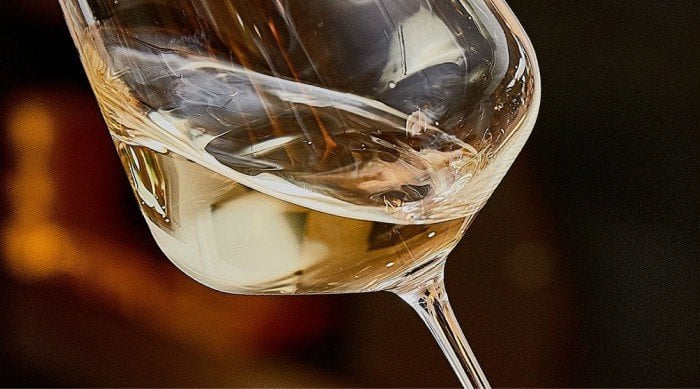
Dessert (fortified) wines are sweeter than most wines and have a higher alcohol content, so the glass for it is designed smaller.
This allows a smaller serving, and the shape is made to direct the wine to the back of the mouth. This keeps the sweetness of the wine, like Sherry or Port, from being overwhelming.
Add these wine glass sets for your dessert wines:
- Zalto Sweet Wine glass
- Riedel Vinum Port Wine glass
5. Other Wine Glasses
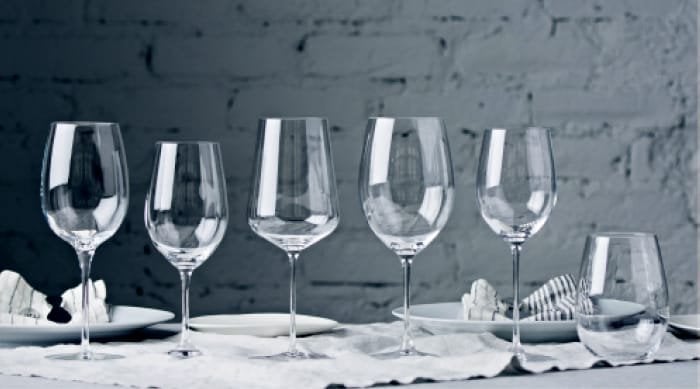
Wine glasses aren’t limited to red, white, sparkling, and dessert varieties. Here are some other styles.
A. Universal glasses
The universal glass is the best option for a pragmatic wine enthusiast who drinks different types of wine and doesn’t want to collect different glass shapes.
Add these universal wine glasses to your dinnerware:
- Libbey Signature Kentfield Estate All Purpose Wine Glass
- Zalto Denk'Art Universal Glass
- Crate and Barrel Viv All Purpose Big Wine Glass
B. Stemless glass for white wine or stemless red wine glass
Elegant stemmed glassware is great for formal occasions, but sometimes you want to have wine in the outdoors or casual settings. You can still have your wine in stemless glasses so that they don’t topple over.
Some stemless wine glasses to consider:
- Rastal Harmony Stemless wine glass
- Ravenscroft Amplifier Vintner’s Tasting Glass
C. Tasters
Tasters are small 6oz glasses for tasting wine— at parties or as a solo drinking glass.
Wine tasters to try:
- Ravenscroft Crystal Essentials International Tasting Glass
- Libbey Wine Party Stemware Glass
D. Acrylic, Tritan™, Stainless Steel, Silicone
If you want a wine glass that’s unbreakable and don’t want to spend on expensive drinkware, you could always consider those made from acrylic, silicone, stainless steel or TritanTM plastic materials. Don’t worry about dropping these tumblers, stemless or stemmed wine glasses.
Some alternative materials wine drinkware:
- Michley Unbreakable Wine Glasses (TritanTM)
- Brovino Silicone Wine Glasses (Silicone)
E. Boccalino
The boccalino isn’t a glass but a mug used in Ticino, Switzerland, for wine drinking. It has a volume of around 200ml.
F. ISO wine tasting glass
This is the glass designated for wine tasting by the International Organization for Standardization (ISO 3591:1977). The ISO wine tasting glass has an elongated egg shape, must be lead crystal (9% lead), and has a volume capacity of about 215ml.
Essential Tips To Remember While Choosing Wine Glasses
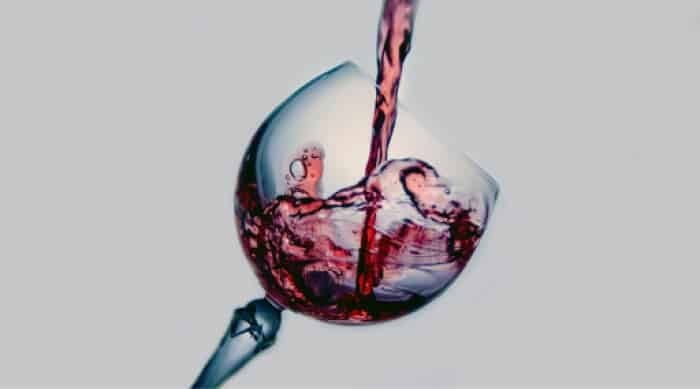
Picking the perfect wine glass to match with your wine collection can be a fun experience. Here are some quick tips to help you along.
1. Size and clarity
You want a thin, transparent glass so you can see your wine clearly. Visual appreciation is part of the wine experience, and thinner glass will also be lighter to hold.
If you plan to get only one or two glasses, consider the space your wine needs to breathe. A glass with at least 20oz volume capacity might be a good option to cover your wine needs.
2. Wine type
Pick a wine glass based on your wine type. If you don’t want to stockpile too many glass shapes in your cabinet, you can always go for the universal glass.
3. Shape and balance
When picking a wine glass, consider these factors:
- Stemmed or stemless
- Stem length
- Foot size
- Bowl shape
- Curve inward slightly at the top
- Rim thickness
All these factors contribute to a well-balanced wine glass.
4. Care and maintenance of wine glasses
Not all wine glasses can go into the dishwasher. You need to hand-wash leaded crystal stemware. You also need to consider if you have space to store that tall Bordeaux glass.
Fine crystal stemware is beautiful to have and elegant to use, but it does require more maintenance than regular glassware. So remember to keep those glasses clean and sparkly!Now that you know how to pick your favorite wine glass, how about filling your wine rack with some fine wines to pour?
Easiest Way to Buy the Best Wines for Your Cellar
Buying wines may sound like a breeze, but there are many factors that come into play: buying an authentic bottle instead of a counterfeit one at the right prices, storing it perfectly so that you can serve it at its peak, and more.
Thankfully, here’s a super-easy way to do it:
Buy Some of the Best Wines in the World through Vinovest
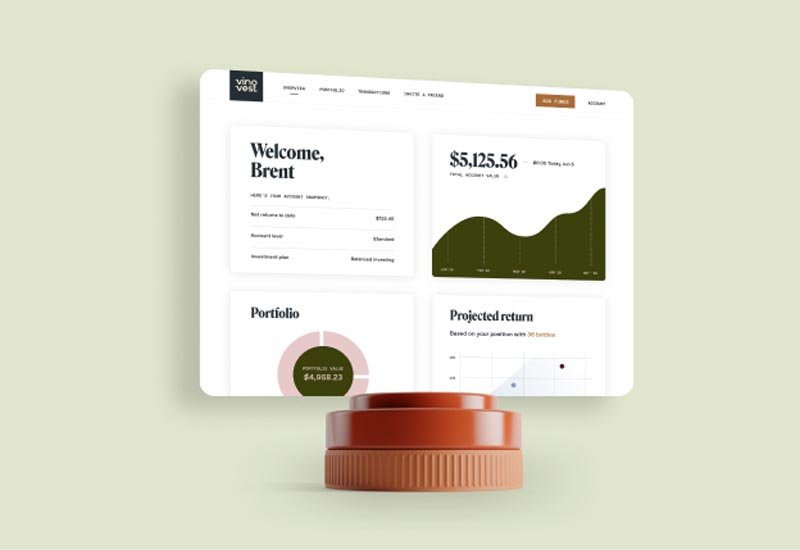
Vinovest is an online wine investment platform with access to a global network to source your fine wines from all over the world.
Vinovest doesn’t just help you buy your wine - they also curate your investment portfolio, authenticate your bottles, insure them, store them, and deliver them to you when you want to take a sip.
What’s more? Vinovest will also help in selling your wine bottles at the right price and time.
Conclusion
The choice of a wineglass isn’t set in stone.
You can start with a standard red wine glass for your reds and a Chardonnay glass for your whites. You can also have more style-specific or varietal specific wine glasses to elevate your wine drinking experience.
And, if you’re building an enviable wine glass collection, matching them to different wines would be equally exciting!
While you’re at it, check out the Vinovest website and sign up on Vinovest to start building your fine wine collection.
